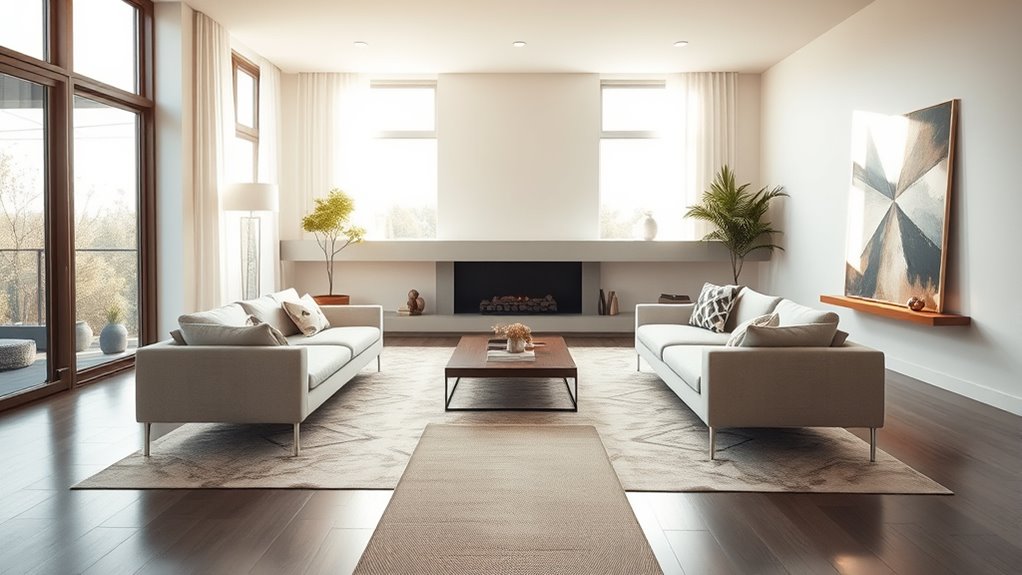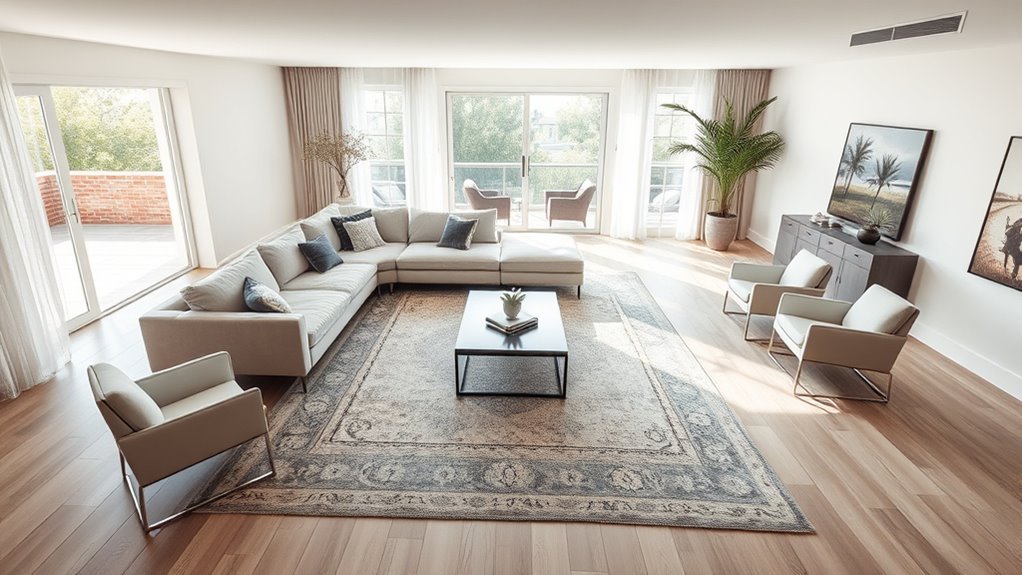To improve flow and maximize space, start by placing furniture thoughtfully, keeping pathways at least 24-30 inches wide for easy movement. Balance large pieces like sofas and artwork to create harmony, and arrange key items like chairs around focal points such as a fireplace or TV. Use scaled furniture that fits your room size and position pieces against walls to open up the center. By considering these tips, you’ll transform your space into a comfortable, inviting environment—learn more to perfect your layout.
Key Takeaways
- Arrange furniture to create clear pathways at least 24-30 inches wide for easy movement.
- Position large pieces against walls or in corners to maximize space and reduce clutter.
- Balance furniture sizes and styles to achieve visual harmony and prevent imbalance.
- Anchor seating around focal points like fireplaces or artwork for natural flow.
- Ensure each piece serves a purpose and contributes to a seamless, functional layout.

Creating a smooth and functional layout begins with understanding how furniture placement influences movement and interaction within a space. When you arrange your furniture thoughtfully, you’ll notice a natural flow that invites conversation and makes everyday activities more comfortable. A key aspect of achieving this flow is paying attention to visual balance. You want your furniture pieces to complement each other without creating clutter or imbalance that can disrupt the eye’s natural movement across the room. For example, balancing a large sofa on one side with a sizable bookcase or artwork on the opposite wall creates harmony, making the space feel intentional and well-organized. This visual balance not only enhances the room’s aesthetic appeal but also helps guide your eye smoothly from one area to another, avoiding awkward dead zones or visual chaos.
Thoughtful furniture placement creates harmony, guiding the eye smoothly and enhancing room aesthetic and flow.
Focal points are equally important when arranging furniture for better flow. They serve as the natural anchors of a room—like a fireplace, a large window with a view, or a statement piece of art—and influence where you position other furniture pieces. When you identify your focal point, you can arrange seating and accessories around it, creating an inviting space that encourages interaction. For instance, if your focal point is a fireplace, arrange chairs and sofas to face it, fostering a cozy environment. If it’s a piece of artwork, position furniture to allow unobstructed views, making the art a highlight. This strategic placement keeps the eye moving comfortably within the space, rather than wandering aimlessly or feeling distracted.
Beyond visual balance and focal points, consider the pathways that connect different zones in your room. Keep walkways at least 24 to 30 inches wide, so people can move freely without feeling cramped. Avoid placing furniture in the middle of these pathways, as it interrupts the flow and creates obstacles. Instead, position larger pieces against walls or in corners, leaving open space for easy navigation. Also, be mindful of the scale of your furniture. Larger pieces should be proportionate to the room’s size to maintain harmony and avoid overcrowding, which hinders movement. Additionally, understanding how furniture arrangement impacts the overall flow can help prevent clutter and maximize usable space, making your room more functional and inviting.
Finally, think about functionality alongside aesthetics. Arrange furniture so that each piece has a purpose and contributes to the overall flow. For example, a coffee table should be accessible from all seating, and side tables should be within reach without cluttering pathways. When you combine visual balance, strategic focal points, and functional flow, you’ll create a space that not only looks great but also feels natural and inviting to everyone who enters.
Frequently Asked Questions
How Do I Maximize Small Room Space Effectively?
To maximize your small room space, start by using multi-purpose furniture that offers storage and functionality, freeing up room. Keep color coordination in mind; light, neutral shades make the space look larger and more open. Arrange furniture to create clear pathways and avoid clutter. You should also consider vertical storage options, like shelves, to make the most of limited space. These tips help your room feel bigger, more organized, and comfortable.
What Are the Best Furniture Shapes for Open Layouts?
For open layouts, choosing furniture shapes like curved pieces creates a natural flow and softens sharp lines, making your space feel more inviting. Modular pieces are also great because you can reconfigure them to suit your needs, keeping the area flexible and functional. Opt for these shapes to enhance openness, encourage easy movement, and maximize your space without cluttering, making your room both stylish and practical.
How Can I Create a Natural Focal Point?
Think of your room as a story, where the focal point is the headline. To create a natural focal point, you should establish a clear visual hierarchy by positioning a statement piece, like a bold art piece or fireplace, in that spot. Use color coordination to draw attention and make it stand out. This approach guides your eye naturally, making your space feel inviting and well-balanced without overwhelming.
Are There Specific Lighting Tips to Improve Flow?
To improve flow with lighting, you should use a mix of ambient and task lighting. Ambient lighting, like ceiling fixtures or wall sconces, creates a comfortable overall glow that guides movement naturally. Task lighting, such as table lamps or under-cabinet lights, highlights specific areas and helps you see clearly without disturbing the room’s flow. Proper placement guarantees you navigate smoothly and feel comfortable in your space.
How Do I Balance Aesthetics and Functionality?
Did you know that homes with balanced aesthetics and functionality report 30% higher satisfaction? To achieve this, you should blend decorative accents and cohesive color schemes that reflect your style. Focus on creating spaces that are visually appealing yet practical, ensuring furniture placement allows easy movement. Use decorative accents to enhance your theme without cluttering. Prioritize function by selecting versatile pieces, and your space will be both beautiful and user-friendly.
Conclusion
By thoughtfully arranging your furniture, you create a space that flows as smoothly as a gentle river. Keep pathways clear and furniture proportional to your room size to invite movement and comfort. When you make intentional choices, your space feels open and welcoming, like a gust of fresh air. Remember, good furniture placement isn’t just about aesthetics—it’s about making your home work for you. With these tips, you’ll turn any room into a harmonious sanctuary.









